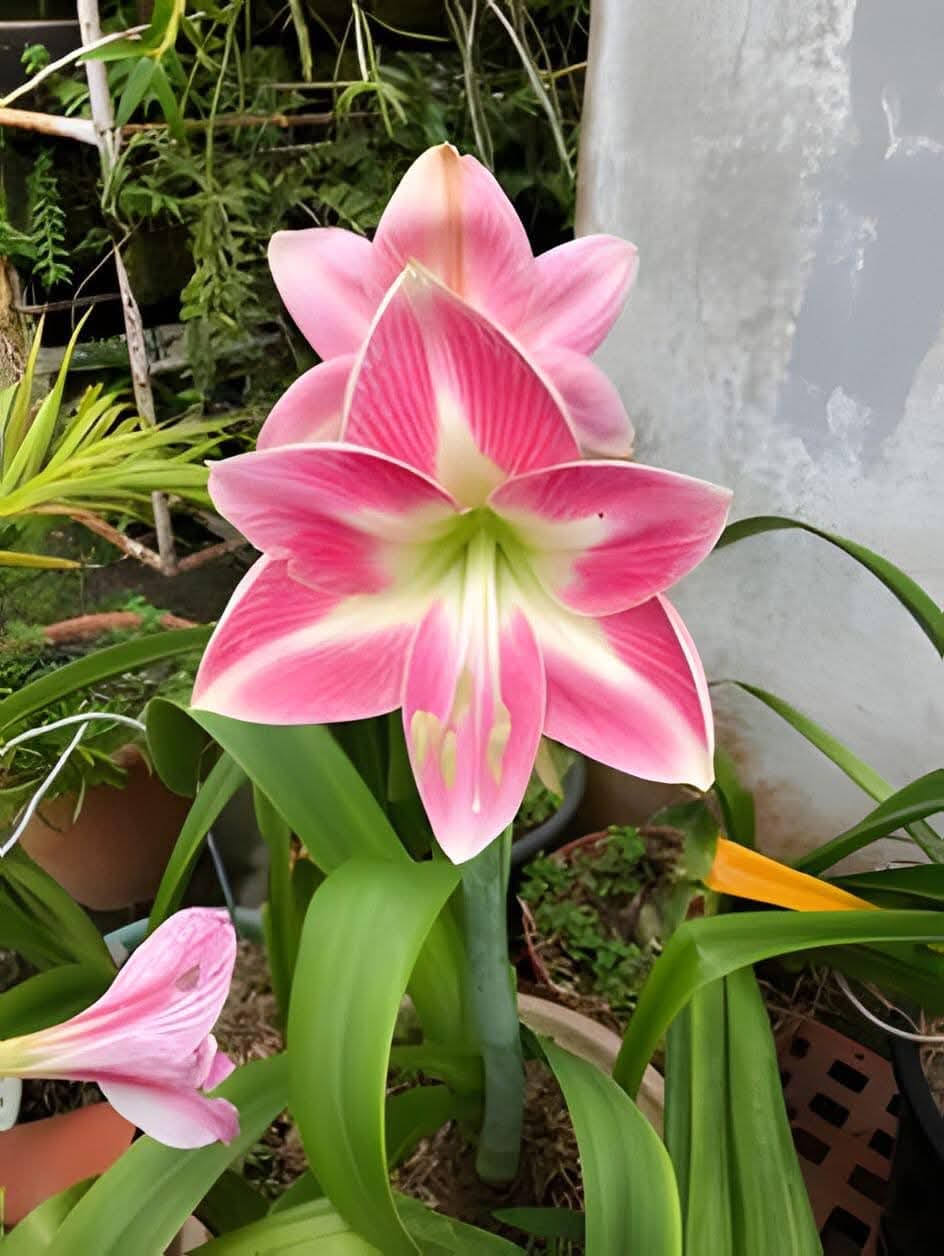Amaryllis (Hippeastrum) is a stunning tropical plant celebrated for its large, trumpet-shaped flowers that appear in a variety of vibrant colors, including red, pink, white, and even bi-colored varieties. While it’s native to tropical regions, its eye-catching blooms have made it a popular choice for gardeners and indoor plant enthusiasts around the world. Growing Amaryllis successfully requires the right conditions, care, and attention, so here’s an in-depth look at how to grow these beautiful plants to their full potential.
Climate: Where Amaryllis Thrives
Amaryllis is a tropical plant, meaning it thrives in warm climates with mild winters. In the United States, Amaryllis is hardy in USDA zones 9-11, which includes areas like Florida, southern California, and parts of Texas. In these zones, Amaryllis can be grown directly in the garden. However, in cooler climates (zones 8 and below), Amaryllis is often grown indoors as a houseplant, especially in the winter months.
If you live in a region with cold winters, don’t worry—you can still enjoy Amaryllis by growing it in containers that can be moved indoors when the temperatures drop. This versatility allows gardeners in various climates to enjoy the beauty of Amaryllis no matter where they live.
Sunlight: The Right Light for Your Amaryllis
Amaryllis plants prefer bright, indirect light. While they do enjoy sunlight, they are sensitive to direct exposure, which can scorch their leaves and hinder their growth. If you’re growing Amaryllis indoors, place them near a bright window where they can receive plenty of natural light, but avoid placing them directly in the path of harsh midday sun. A windowsill with filtered light is ideal, as it will provide the plant with enough light to thrive without causing any damage.
Outdoors, if you live in a region where temperatures are warm enough to grow Amaryllis year-round, place them in a location where they can receive partial shade during the hottest parts of the day. This will keep the plant from becoming stressed while still allowing it to get the light it needs to produce those vibrant blooms.
Soil: The Best Growing Medium for Amaryllis
When it comes to soil, Amaryllis plants prefer a well-draining potting mix, specifically designed for container plants. It is crucial to avoid using garden soil, as it tends to compact in pots, making it difficult for water to drain properly. If the soil doesn’t drain well, the roots may become waterlogged, leading to bulb rot and other issues.
A good-quality potting mix that contains peat, perlite, and other materials that promote good drainage is ideal for Amaryllis. Additionally, adding a bit of coarse sand or orchid bark to the mix can improve drainage and help mimic the plant’s natural growing conditions.
Potting: Choose the Right Container
Amaryllis grows from a large bulb, so when choosing a pot, select one that is only slightly larger than the bulb. The pot should have good drainage holes at the bottom to prevent water from accumulating and causing root rot. Aim for a pot that’s about 1-2 inches wider in diameter than the bulb, ensuring that the bulb has enough space to grow, but not too much room, as excess space can lead to stagnant water around the bulb.
The most important aspect of potting is to ensure that the top third of the bulb remains above the soil line. This helps prevent the bulb from becoming too submerged, which could lead to poor growth or rot.
Planting: Positioning Your Amaryllis Bulb
When it comes to planting your Amaryllis, the most important step is to ensure that the bulb is positioned properly. Place the bulb in the pot with its roots facing downward and the pointed tip of the bulb facing up. Leave the top third of the bulb exposed above the surface of the soil. This allows the plant to establish itself while preventing the bulb from being buried too deeply.
After planting, water the bulb thoroughly to settle the soil around it. However, it’s important to let the soil dry out slightly between waterings. Overwatering can be detrimental, so be sure to check the soil regularly and only water when it feels dry to the touch.
Temperature: Maintaining Ideal Growing Conditions
Amaryllis plants prefer temperatures between 65-75°F (18-24°C) during their growing season. They are sensitive to extreme temperature fluctuations, so it’s best to keep them in a stable environment where the temperature remains consistent. This range is ideal for promoting healthy growth and vibrant blooms.
If you are growing Amaryllis indoors, avoid placing them near drafts or heat sources, such as radiators or air conditioners. Sudden temperature changes can stress the plant and affect its blooming cycle. Outdoor plants in warmer climates will naturally experience the right temperatures during their growing season, but it’s essential to protect them from frost.
Watering: The Key to Healthy Amaryllis
Watering Amaryllis is an art that requires some attention to detail. After planting the bulb, water it thoroughly, ensuring the water drains freely from the bottom of the pot. However, once the plant has been watered, it’s important to let the soil dry out somewhat before watering again. Overwatering can lead to bulb rot, which is one of the most common causes of failure in Amaryllis plants.
As the plant grows and enters its flowering stage, be mindful of its water needs. During the blooming season, water moderately to keep the plant hydrated but never allow the pot to sit in water. Once the flowers have faded and the plant enters its dormancy period, reduce watering further until the leaves die back completely.
Fertilizing: Nourish for Healthy Blooms
Amaryllis plants benefit from regular feeding once the flower buds start to emerge. A balanced, water-soluble liquid fertilizer can be applied every 2-4 weeks during the growing season. Choose a fertilizer that is rich in potassium and phosphorus, as these nutrients help promote strong blooms and healthy root development.
It’s important not to over-fertilize, as excessive nutrients can lead to weak growth and a lack of blooms. Always follow the manufacturer’s instructions for the correct dosage, and avoid fertilizing during the plant’s dormant period.
Flowering: A Beautiful Display
Amaryllis typically blooms in winter or spring, depending on when it was planted. If you plant it in late fall, you can expect vibrant blooms in the early spring. If grown in optimal conditions, the plant will produce large, showy flowers that last for several weeks, making it a beautiful centerpiece in your home.
The bloom cycle of Amaryllis is relatively short, but it’s a spectacular one. You can enjoy the flowers for a few weeks before they fade. Afterward, it’s important to prune the spent flowers and continue caring for the plant as it prepares for the next blooming season.
Post-Bloom Care: Helping Your Amaryllis Recharge
After the flowers fade, you may feel tempted to throw the plant away, but don’t do that just yet. Amaryllis continues to grow and replenish its bulb after blooming. To help the plant recover, cut back the flower stalk to about an inch above the bulb, but leave the leaves intact. Continue watering and fertilizing to allow the plant to build energy for the next bloom cycle.
Dormancy: Time for Rest
In some cases, Amaryllis will enter a dormancy period after blooming. The leaves will begin to yellow and die back, signaling that the plant needs a rest before starting the growing cycle again. At this point, reduce watering and allow the bulb to rest for 6-8 weeks. During this time, the plant will conserve energy and prepare for the next growing season.
Once the dormant period is over, you can begin watering the bulb again and resume the care regimen to encourage new growth and blooms.
Conclusion
Growing Amaryllis is a rewarding experience that brings stunning flowers into your home or garden. By providing the right growing conditions—adequate sunlight, well-draining soil, proper watering, and thoughtful care during flowering and dormancy—you can enjoy beautiful blooms year after year. Whether you’re growing Amaryllis as a houseplant or in your garden, its vibrant flowers will brighten up any space and remind you of the beauty of tropical plants.
More Articles You Might Like
-
Texas Toast Sloppy Joes: The Crunchy, Cheesy Upgrade You Didn’t Know You Needed
There’s something timeless about sloppy joes. For generations, this saucy, savory, and slightly sweet ground beef sandwich has been a go-to comfort food in American kitchens. It’s quick, filling, and family-friendly—perfect for busy weeknights. But what if we told you there’s a way to take this classic dish up a notch? Enter the Texas Toast…
-
Classic Pig Pickin’ Cake
When it comes to Southern desserts, few sweets shine as brightly as the Classic Pig Pickin’ Cake. This nostalgic cake, sometimes called a “Mandarin Orange Cake,” has roots deep in Southern tradition. It gets its playful name from its frequent appearance at pig pickin’s—Southern-style barbecue gatherings where communities come together to enjoy slow-cooked pork, sides,…
-
Lemon Garlic Butter Chicken with Creamy Parmesan Pasta
There’s something irresistible about the combination of tender, golden-browned chicken paired with a creamy pasta coated in Parmesan cheese. Add the brightness of lemon, the depth of garlic, and the richness of butter, and you have a recipe that feels indulgent yet approachable enough for a weeknight dinner. Lemon Garlic Butter Chicken with Creamy Parmesan…



